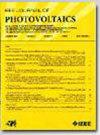CdSe With Mixed Zincblende and Wurtzite Phases Grown on Lattice-Matched InAs Substrates Using Molecular Beam Epitaxy
IF 2.5
3区 工程技术
Q3 ENERGY & FUELS
引用次数: 0
Abstract
The II–VI compound semiconductor CdSe, which has both zincblende (ZB) and wurtzite (WZ) phases with bandgap energies of 1.67 and 1.74 eV, respectively, is an ideal candidate material for the top cell in a tandem solar cell with a Si bottom cell to achieve higher power conversion efficiency. In this work, molecular beam epitaxy growth of CdSe thin films on lattice-matched InAs(100) substrates reveals a single-phase ZB structure with high crystallinity and a low defect density. In contrast, all CdSe layers grown on InAs(111)B substrates have mixed ZB and WZ phases in coexistence, as confirmed by high-resolution X-ray diffraction, transmission electron microscopy (TEM), and photoluminescence (PL) measurements. The PL efficiencies of the CdSe layers grown on (111)B substrates are substantially lower than those grown on (100) substrates. This result is attributed to defects at the boundaries between the two different phases. Postgrowth annealing of CdSe layers grown on InAs(111)B at 250–450 °C converts most of the CdSe ZB material into the WZ phase, as evidenced by improved PL efficiency and TEM images. Density functional theory simulations confirm that the formation energy difference between the ZB and WZ phases for CdSe is very small compared with other conventional compound semiconductors, which is in good agreement with the experimental observations.利用分子束外延技术在晶格匹配的 InAs 基底上生长出锌斜长石和钨斜长石混合相的硒化镉
硒化镉(CdSe)是一种 II-VI 族化合物半导体,具有菱锌矿相(ZB)和钝锌矿相(WZ),带隙能分别为 1.67 和 1.74 eV,是串联太阳能电池中顶层电池与硅底层电池的理想候选材料,可实现更高的功率转换效率。在这项研究中,在晶格匹配的 InAs(100)衬底上通过分子束外延生长出的硒化镉薄膜显示出具有高结晶度和低缺陷密度的单相 ZB 结构。相比之下,在 InAs(111)B 衬底上生长的所有硒化镉层都具有混合共存的 ZB 和 WZ 相,这一点已通过高分辨率 X 射线衍射、透射电子显微镜 (TEM) 和光致发光 (PL) 测量得到证实。生长在(111)B基底上的碲化镉层的聚合效率大大低于生长在(100)基底上的碲化镉层。造成这一结果的原因是两种不同相之间的边界存在缺陷。在 InAs(111)B 上生长的硒化镉层在 250-450 ℃ 下进行生长后退火处理后,大部分硒化镉 ZB 材料转化为 WZ 相,PL 效率的提高和 TEM 图像都证明了这一点。密度泛函理论模拟证实,与其他传统化合物半导体相比,硒化镉 ZB 相和 WZ 相之间的形成能差非常小,这与实验观察结果非常吻合。
本文章由计算机程序翻译,如有差异,请以英文原文为准。
求助全文
约1分钟内获得全文
求助全文
来源期刊

IEEE Journal of Photovoltaics
ENERGY & FUELS-MATERIALS SCIENCE, MULTIDISCIPLINARY
CiteScore
7.00
自引率
10.00%
发文量
206
期刊介绍:
The IEEE Journal of Photovoltaics is a peer-reviewed, archival publication reporting original and significant research results that advance the field of photovoltaics (PV). The PV field is diverse in its science base ranging from semiconductor and PV device physics to optics and the materials sciences. The journal publishes articles that connect this science base to PV science and technology. The intent is to publish original research results that are of primary interest to the photovoltaic specialist. The scope of the IEEE J. Photovoltaics incorporates: fundamentals and new concepts of PV conversion, including those based on nanostructured materials, low-dimensional physics, multiple charge generation, up/down converters, thermophotovoltaics, hot-carrier effects, plasmonics, metamorphic materials, luminescent concentrators, and rectennas; Si-based PV, including new cell designs, crystalline and non-crystalline Si, passivation, characterization and Si crystal growth; polycrystalline, amorphous and crystalline thin-film solar cell materials, including PV structures and solar cells based on II-VI, chalcopyrite, Si and other thin film absorbers; III-V PV materials, heterostructures, multijunction devices and concentrator PV; optics for light trapping, reflection control and concentration; organic PV including polymer, hybrid and dye sensitized solar cells; space PV including cell materials and PV devices, defects and reliability, environmental effects and protective materials; PV modeling and characterization methods; and other aspects of PV, including modules, power conditioning, inverters, balance-of-systems components, monitoring, analyses and simulations, and supporting PV module standards and measurements. Tutorial and review papers on these subjects are also published and occasionally special issues are published to treat particular areas in more depth and breadth.
 求助内容:
求助内容: 应助结果提醒方式:
应助结果提醒方式:


